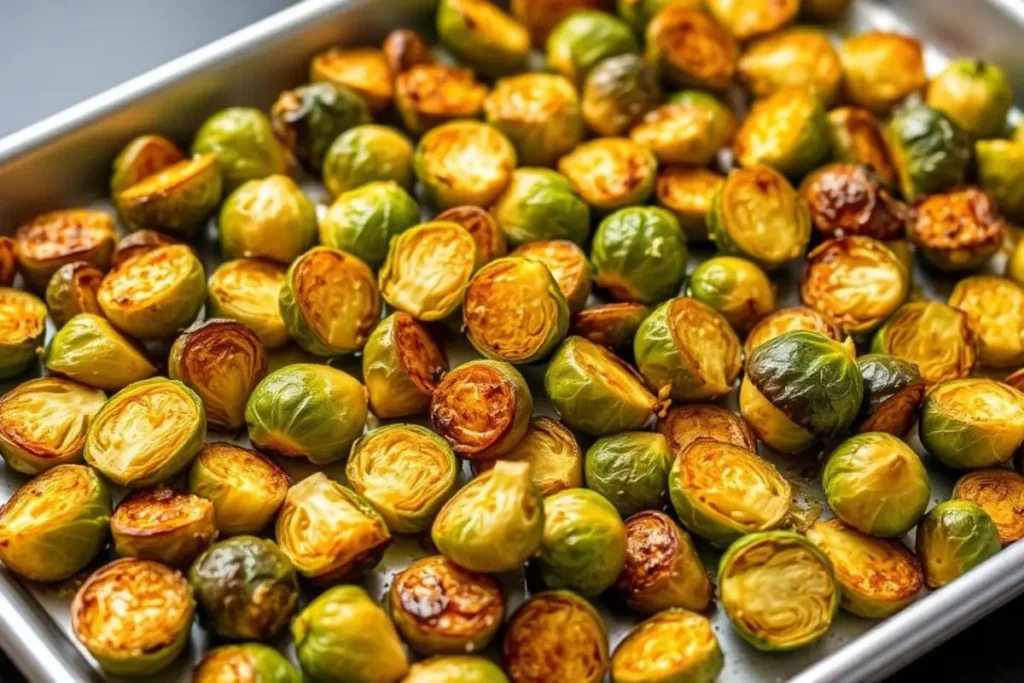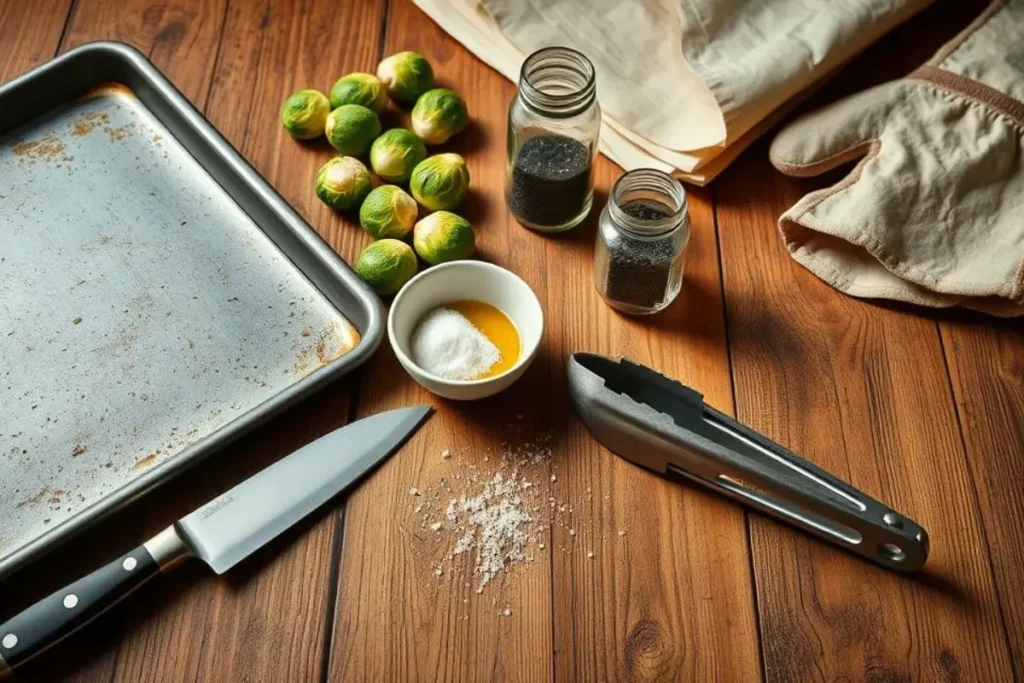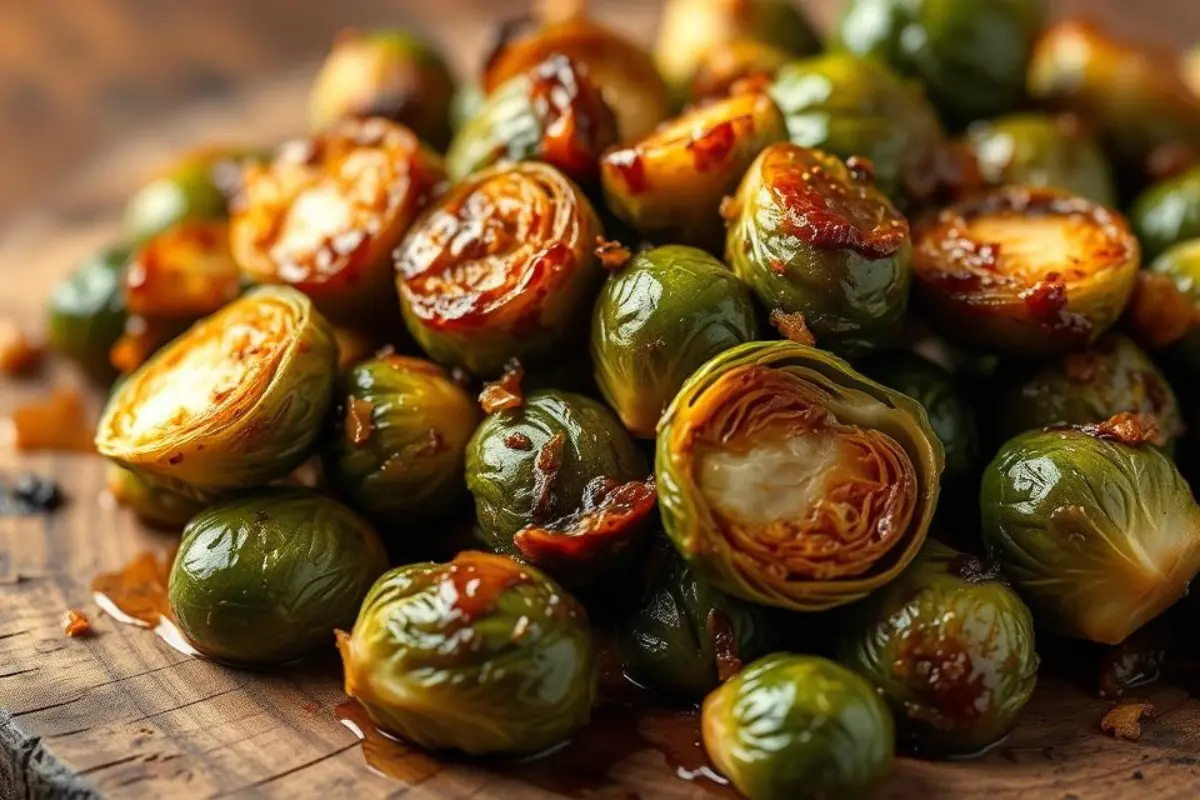Turn the Brussels sprout from a dinner table foe into a meal star with perfect Roasted Brussels Sprouts. These small green balls get a sweet, nutty taste and a crispy outside when roasted hot. This is a big change from the mushy, bitter ones we remember from childhood.
Roasting Brussels sprouts makes them sweet through caramelization and adds a great texture. The crispy outside and soft inside make them irresistible. Even those who don’t like Brussels sprouts often change their mind after trying them roasted.
This guide will show you why roasting is the best way to cook Brussels sprouts. You’ll learn how to make perfect roasted Brussels sprouts every time. Plus, we’ll share tips on choosing the freshest sprouts and storing leftovers. This way, you can enjoy this tasty, healthy vegetable for any meal.
Key Takeaways
- Roasting Brussels sprouts creates sweet, nutty flavors through caramelization
- High-heat cooking transforms the texture with crispy exteriors and tender centers
- Proper preparation techniques prevent common issues like bitterness
- Roasted Brussels sprouts recipes can be customized with various seasonings
- Brussels sprouts deliver impressive nutritional benefits while being low in calories
- Correct roasting methods preserve more nutrients than boiling or steaming
Why Roasting Is the Best Way to Cook Brussels Sprouts
Roasting turns brussels sprouts into crispy, tasty treats that everyone loves. It brings out their natural sweetness and gives them a perfect texture. This makes it the best way to cook brussels sprouts for both newbies and seasoned cooks.
The Science Behind Caramelization
Roasting brussels sprouts triggers a chemical change called the Maillard reaction. This process breaks down sugars, creating new flavors. The dry heat of roasting makes them caramelized with rich, nutty tastes that other methods can’t match.
Texture and Flavor Benefits
The magic of roasting brussels sprouts is in their texture. The outside becomes crisp, while the inside remains soft and tender. This mix of textures makes each bite enjoyable. Roasting also reduces bitterness by breaking down compounds that make raw sprouts taste sharp.

Comparison to Other Cooking Methods
Roasting is better than other ways to cook brussels sprouts for several reasons:
| Cooking Method | Texture Result | Flavor Profile | Preparation Ease |
|---|---|---|---|
| Roasting | Crispy outside, tender inside | Sweet, nutty, caramelized | Simple prep, hands-off cooking |
| Steaming | Soft throughout | Mild, sometimes bitter | Quick but requires monitoring |
| Boiling | Often mushy | Bland, sulfurous smell | Easy but timing-sensitive |
| Sautéing | Crisp but uneven cooking | Good flavor, less caramelization | Requires constant attention |
- Roasting minimizes the sulfurous odors that make many people avoid brussels sprouts
- The dry heat environment creates natural browning impossible with wet cooking methods
- Roasting requires minimal hands-on time, making it practical for busy cooks
- The roasting brussels sprouts benefits include better nutrient retention compared to boiling
Essential Ingredients and Tools for Perfect Roasted Brussel Sprouts & Step-by-Step Guide
To make perfectly roasted brussels sprouts, you need good ingredients and tools. Your pantry should have fresh brussels sprouts, quality olive oil, kosher salt, and black pepper. These are the basic ingredients for roasted brussels sprouts.
You’ll also need a sharp knife, a sturdy sheet pan, parchment paper, and a mixing bowl. These tools help with even cooking and make cleanup easy.

Preparing Your Brussels Sprouts
Begin by cutting off the woody stem ends and removing any bad outer leaves. Cut bigger sprouts in half lengthwise for even cooking. Then, rinse them well and dry with paper towels. This step is important to prevent moisture from stopping caramelization.
Seasoning Options for Maximum Flavor
While salt and pepper are basic, you can add more flavors:
- Balsamic glaze or honey for sweetness
- Garlic and lemon zest for brightness
- Red pepper flakes for heat
- Parmesan cheese for nutty richness
Determining the Ideal Cooking Temperature and Time
Heat your oven to 400-425°F for the best results. Toss the sprouts with olive oil until they’re lightly coated. Then, spread them out on your pan, cut-side down. Roast for 20-25 minutes, depending on their size.
How to Test for Doneness
Check for deep golden brown edges and easily pierced centers. The outer leaves should be crispy and dark. Remember, they’ll keep cooking a bit after you take them out of the oven. So, pull them just before they’re tender enough for you.
Common Mistakes to Avoid & Mouthwatering Variations
Even with the best ingredients, roasting brussels sprouts can go wrong if you make certain mistakes. Knowing these common errors will make your results much better.
Overcrowding the Pan
Space is key when roasting brussels sprouts. Too many sprouts on one sheet create steam, not caramelization. Make sure to leave space between each sprout for a golden-brown exterior.
Using Too Little Oil
Oil does more than prevent sticking—it helps with heat conduction and browning. For a pound of sprouts, use 1-2 tablespoons of oil. Coat each piece well for the best roasting results.
Not Cutting Them Properly
The way you cut brussels sprouts affects cooking. Cut larger sprouts in half through the stem end for caramelization. Keep small sprouts whole to avoid overcooking.
Incorrect Oven Temperature
Temperature is crucial when avoiding roasting mistakes. Too low (under 375°F) makes sprouts mushy; too high (over 450°F) burns them before they’re cooked. Aim for 400-425°F for perfect sprouts.
- Garlic roasted brussels sprouts with parmesan cheese for a savory, nutty flavor
- Balsamic brussels sprouts recipe with a honey glaze for sweet-tangy perfection
- Roasted brussels sprouts with bacon and maple syrup for an irresistible sweet-savory combo
- Asian-inspired soy-ginger sprouts with sesame seeds
- Spicy harissa roasted sprouts for a bold kick
- Mediterranean-style with lemon zest and fresh herbs
Health Benefits, Storage, and Reheating Tips
Roasted brussels sprouts are not just tasty but also super nutritious. A 1-cup serving has only 56 calories but is rich in fiber and vitamins. They are full of vitamins C, K, and B6, and minerals like manganese and potassium. These sprouts also have antioxidants that fight stress and inflammation.
Roasted brussels sprouts are great for your digestive health. They have lots of fiber and compounds that help your gut. Roasting them keeps more nutrients than boiling and makes some compounds easier to use by your body.
To keep your roasted brussels sprouts fresh, cool them down fast and store them in a sealed container in the fridge for up to 4 days. For longer storage, freeze them by spreading them on a baking sheet first. Then, put them in a freezer-safe bag or container once they’re frozen solid. To reheat, place them in the oven at 400°F for approximately 10 minutes. This will make them crispy and tender again.
FAQ
What are the benefits of roasting Brussels sprouts?
Roasting is the most effective method for cooking Brussels sprouts. It starts the Maillard reaction, which turns the natural sugars into complex, nutty flavors. This method also makes the sprouts crispy on the outside and tender on the inside. It even mellow out any bitterness.
What ingredients and tools do I need for perfect roasted Brussels sprouts?
You’ll need high-quality olive oil, kosher salt, and freshly ground black pepper. You might also want to try balsamic vinegar, honey, or garlic for extra flavor. You’ll need a heavy-duty baking sheet, parchment paper, and a sharp knife for cutting.
How do I prepare and roast Brussels sprouts for the best results?
Choose fresh, firm Brussels sprouts and remove any damaged leaves. Trim the stems and cut larger sprouts in half. Toss them with olive oil, salt, and pepper, then spread them on your baking sheet. Roast at 400°F to 425°F for 20-25 minutes, tossing halfway, until they’re caramelized and tender.
What common mistakes should I avoid when roasting Brussels sprouts?
Avoid overcrowding the pan and using too little oil. Make sure to cut the sprouts right and roast at the right temperature (400°F to 425°F). This will help them get crispy.
What are some tasty variations on roasted Brussels sprouts?
Try honey-balsamic glazed, garlic and parmesan, or Brussels sprouts with bacon and maple syrup. You can also go for Asian-inspired soy-ginger, spicy harissa, or Mediterranean-style with lemon and herbs.
What health benefits do roasted Brussels sprouts offer?
Brussels sprouts are full of vitamins, minerals, fiber, and antioxidants. Roasting them preserves more nutrients than boiling. They’re rich in vitamin C, vitamin K, folate, and glucosinolates, which fight inflammation and cancer.
How should I store and reheat roasted Brussels sprouts?
Cool them down completely, then refrigerate in an airtight container for up to 4 days. They can be stored in the freezer for as long as 6 months. Reheat in the oven at 400°F for 5-10 minutes or in short microwave bursts to keep them crispy.

